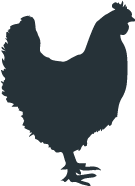Veterinary advice should be sought from your local veterinarian before applying any treatment or vaccine. Not sure who to use? Look up veterinarians who specialize in poultry using our directory listing. Find me a Vet
| Name | Summary | |
|---|---|---|
| Supportive care | Isolate the bird from the flock and place in a safe, comfortable, warm location (your own chicken "intensive care unit") with easy access to water and food. Limit stress. Call your veterinarian. | |
| Modification of diet | Stop feeding table scraps and choose a lower protein feed. | |
| Omega-3 fatty acids and Vitamin E | Added to the diet at 0.22 ml/kg. Concurrently add 160 mg/kg of Vitamin E (since the bird's requirements for dietary vitamin E will increase and it's protective value) | O Cojean et al., 2020; A Sekikawa et al., 2019; C Petzinger et al 2013; N Ozer et al |
| Niacin | Used to help lower total cholesterol | N Ruperelia et al., 2011; D Meyers et al., 2004; |
| Isoxsuprine | 5-10 mg/kg PO | Fitzgerald, Brenna Colleen et al., 2018; Simone-Freilicher, Elisabeth., 2007 |
| Propolis | 0.25 g/kg | I Klaric et al., 2018; Nader et al., 2010 |
| Sotalol | 1 mg/kg PO BID | S Oster et al., 2019 |
| Calcium channel blockers | Diltiazem, Nifedipine, Verapamil | Pérez, B. García, et al |
| Atorvastatin | 10 mg/kg PO q 12 h | J Robertson et al |
| Vitamin C | 600 mg/kg diet | S Hassan et al |

© 2026 PoultryDVM All Rights Reserved.